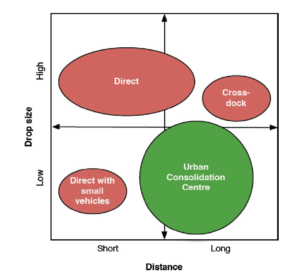City logistics will become more complex and costly. The demand for city logistics grows because of urbanization. Most urbanization takes place in emerging economies leading, amongst others, to the rapid emergence of highly dense megacities. Research by Vrije Universiteit Brussels (B) looks at alternative urban freight options for deliveries to megacities
Challenges in megacities
The city logistics challenges might be similar to other cities but in megacities are more magnified and considerably impact the performance of transport operators; infrastructure demand versus supply, congestion, a lack of (un)loading bays, restrictive measures, insufficient planning and logistics sprawl leading to longer distances to the final receiver (B2B or B2C).
At the same time a fragmentation of freight flows, particularly consumer goods, occurs. This is caused by increased delivery frequency, lower inventory levels, more delivery addresses and just-in-time deliveries.
Logistics cost models fail for urban freight
Existing logistics cost models for urban areas do not take these more recent challenges sufficiently into account. In order to cope with these challenges, alternative ways of transporting goods in the last mile emerge; (horizontal) collaboration in an urban consolidation centre (UCC), multi-echelon networks, initiatives such as crowdsourcing, the use of lockers and the deployment of alternative vehicles.
Mathematical model
A mathematical model was developed to calculate the costs of alternative distribution set-ups for last mile transportation in a supply chain with small and fragmented volumes. The model is based on input from logistics cost models for urban areas combined with cost variables related to logistics processes, receiver attributes and local city characteristics.
The cost variables for each stakeholder influence the cost-effectiveness and applicability of alternative distribution set-ups. The model is applied on the delivery of fast moving consumer goods (FMCG) towards small independent retailers in a megacity. The current supply of these stores is characterized by high costs, inefficiency and unsustainability.
This study aimed to fill these gaps by modelling the cost-effectiveness of alternative distribution set-ups to improve the efficiency of fragmented freight flows. The model is based on logistics processes and takes into account receiver attributes and local context, which other studies do not include. Each aspect has different cost variables that influence the applicability and transferability of a distribution set-up. In order to validate the model it is applied on the highly fragmented supply of fast moving consumer goods (FMCG) towards small independent retailers (nano stores).
Modelling options
Four different set-ups were modelled. The model shows the effects of different city and store request parameters. When drop sizes are low and distances are short, direct shipments with smaller vehicles outperform the current direct set-up. When drop sizes are low and distances are long, collaborating in an urban consolidation centre shows a saving. This model can be further deployed and validated with data from other cities, other distribution set-ups and other goods flows
Source:
Kin, B., Spoor, J., Verlinde, S., Macharis, C., & van Woensel, T. (2017). Modelling alternative distribution set-ups for fragmented last mile transport: towards more efficient and sustainable urban freight transport. Case Studies on Transport Policy.

